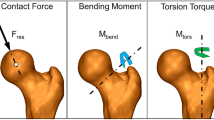Abstract
Aim
To determine whether load directions for stumbling are similar to those for common activities and whether stumbling can be realistically simulated under laboratory conditions without endangering the patients.
Method
The magnitudes and directions of hip contact forces were measured during real and simulated stumbling and compared with those found during various other everyday activities. Measurements were obtained by use of hip implants with built-in load sensors and telemetry.
Results
Peak forces are approximately twice as high during real stumbling as during any other activity and may range higher than eight-times the body weight. Simulated stumbling leads to much lower contact forces, especially if this happens after a warning. Accidental stumbling in everyday situations should, therefore, be avoided, especially in patients with hip replacements or arthrosis.
Conclusions
The directions of peak hip contact forces relative to the femoral bone are nearly constant for any activity, including real stumbling. This observation supports the assumption that muscle and bone anatomy plus muscle function are optimized in order to minimize stresses in bone and muscles. Any impairment of such a mechanically balanced system will increase the musculoskeletal loads. Malposition of total hip implants or muscle deficits caused by the surgical approach must, therefore, be avoided or minimized.




Similar content being viewed by others
References
Bergmann G, Graichen F, Rohlmann A (1995) Is staircase walking a risk for the fixation of hip implants? J Biomech 28:535–553
Heller M, Bergmann G, Deuretzbacher G, Claes L, Haas NP, Duda GN (2001) Influence of femoral anteversion on proximal femoral loading: measurement and simulation in four patients. Clin Biomech 16:644–649
Rydell NW (1966) Forces acting in the femoral head-prosthesis. Acta Orthop Scand 7 [Suppl 88]
Davy DT, Kotzar GM, Brown RH, Heiple KGSR, Goldberg VM, Heiple KG Jr, Berilla J, Burstein AH (1988) Telemetric force measurements across the hip after total arthroplasty. J Bone Joint Surg 70-A:45–50
Bergmann G, Graichen F, Siraky J, Jendrzynski H, Rohlmann A (1988) Multichannel strain gauge telemetry for orthopaedic implants. J Biomech 21:169–176
Graichen F, Bergmann G, Rohlmann A (1999) Hip endoprosthesis for in vivo measurement of joint force and temperature. J Biomech 32:1113–1117
Graichen F, Bergmann G (1991) Four-channel telemetry system for in vivo measurement of hip joint forces. J Biomed Engineering 13:370–374
Bergmann G, Graichen F, Rohlmann A (1998) Loads acting at the hip joint. In: Sedel L, Cabanela ME (eds) Hip surgery—new materials and developments. Dunitz, London, pp 1–8
Bergmann G, Graichen F, Rohlmann A (1993) Hip joint forces during walking and running, measured in two patients. J Biomech 26:969–990
Bergmann G, Graichen F, Rohlmann A (1997) Hip joint forces during load carrying. Clin Orthop 335:190–201
Bergmann G, Kniggendorf H, Graichen F, Rohlmann A (1995) Influence of shoes and heel strike on the loading of hip implants. J Biomech 28:817–827
Bergmann G, Graichen F, Rohlmann A (2001) Hip contact forces and gait patterns from routine activities. J Biomech 34:859–871
Bergmann G (ed) (2001) HIP98—Loading of the hip joint. Free University of Berlin. Compact disc, ISBN 3980784800
Heller M, Bergmann G, Deuretzbacher G, Dürselen L, Pohl M, Claes L, Duda GN (2001) Musculo-skeletal loading conditions during walking and stair climbing. J Biomech 34:883–893
Wolff J (1892) Das Gesetz der Transformation der Knochen. Hirschwald, Berlin
Acknowledgements
This study was supported by the German Research Foundation (BE 804-11).
Author information
Authors and Affiliations
Corresponding author
Rights and permissions
About this article
Cite this article
Bergmann, G., Graichen, F. & Rohlmann, A. Hip joint contact forces during stumbling. Langenbecks Arch Surg 389, 53–59 (2004). https://doi.org/10.1007/s00423-003-0434-y
Received:
Accepted:
Published:
Issue Date:
DOI: https://doi.org/10.1007/s00423-003-0434-y




